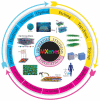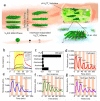MXenes as Emerging Materials: Synthesis, Properties, and Applications
- PMID: 35956859
- PMCID: PMC9370057
- DOI: 10.3390/molecules27154909
MXenes as Emerging Materials: Synthesis, Properties, and Applications
Abstract
Due to their unique layered microstructure, the presence of various functional groups at the surface, earth abundance, and attractive electrical, optical, and thermal properties, MXenes are considered promising candidates for the solution of energy- and environmental-related problems. It is seen that the energy conversion and storage capacity of MXenes can be enhanced by changing the material dimensions, chemical composition, structure, and surface chemistry. Hence, it is also essential to understand how one can easily improve the structure-property relationship from an applied point of view. In the current review, we reviewed the fabrication, properties, and potential applications of MXenes. In addition, various properties of MXenes such as structural, optical, electrical, thermal, chemical, and mechanical have been discussed. Furthermore, the potential applications of MXenes in the areas of photocatalysis, electrocatalysis, nitrogen fixation, gas sensing, cancer therapy, and supercapacitors have also been outlooked. Based on the reported works, it could easily be observed that the properties and applications of MXenes can be further enhanced by applying various modification and functionalization approaches. This review also emphasizes the recent developments and future perspectives of MXenes-based composite materials, which will greatly help scientists working in the fields of academia and material science.
Keywords: 2D materials; MXenes; MXenes composites; layered materials; max phases.
Conflict of interest statement
The authors declare no conflict of interest.
Figures













Similar articles
-
MXenes: Are they emerging materials for analytical chemistry applications? - A review.Anal Chim Acta. 2021 Jan 25;1143:267-280. doi: 10.1016/j.aca.2020.08.063. Epub 2020 Sep 6. Anal Chim Acta. 2021. PMID: 33384123 Review.
-
Solid-Solution MXenes: Synthesis, Properties, and Applications.Acc Chem Res. 2024 Oct 15;57(20):3007-3019. doi: 10.1021/acs.accounts.4c00387. Epub 2024 Oct 2. Acc Chem Res. 2024. PMID: 39357063
-
Applications of 2D MXenes in energy conversion and storage systems.Chem Soc Rev. 2019 Jan 2;48(1):72-133. doi: 10.1039/c8cs00324f. Chem Soc Rev. 2019. PMID: 30387794 Review.
-
Ti3C2T x MXenes-based flexible materials for electrochemical energy storage and solar energy conversion.Nanophotonics. 2022 Jun 9;11(14):3215-3245. doi: 10.1515/nanoph-2022-0228. eCollection 2022 Jul. Nanophotonics. 2022. PMID: 39635552 Free PMC article. Review.
-
Emerging 2D MXenes for supercapacitors: status, challenges and prospects.Chem Soc Rev. 2020 Sep 21;49(18):6666-6693. doi: 10.1039/d0cs00175a. Chem Soc Rev. 2020. PMID: 32781463 Review.
Cited by
-
Nano-Innovations in Cancer Therapy: The Unparalleled Potential of MXene Conjugates.Materials (Basel). 2024 Mar 20;17(6):1423. doi: 10.3390/ma17061423. Materials (Basel). 2024. PMID: 38541577 Free PMC article. Review.
-
MXenes and artificial intelligence: fostering advancements in synthesis techniques and breakthroughs in applications.RSC Adv. 2024 Nov 21;14(49):36835-36851. doi: 10.1039/d4ra06384h. eCollection 2024 Nov 11. RSC Adv. 2024. PMID: 39574930 Free PMC article. Review.
-
MXene-Based Photocatalysts in Degradation of Organic and Pharmaceutical Pollutants.Molecules. 2022 Oct 16;27(20):6939. doi: 10.3390/molecules27206939. Molecules. 2022. PMID: 36296531 Free PMC article. Review.
-
A comprehensive overview of recent progress in MXene-based polymer composites: Their fabrication processes, advanced applications, and prospects.Heliyon. 2024 Aug 30;10(17):e37030. doi: 10.1016/j.heliyon.2024.e37030. eCollection 2024 Sep 15. Heliyon. 2024. PMID: 39319124 Free PMC article. Review.
-
Emerging Trends and Recent Progress of MXene as a Promising 2D Material for Point of Care (POC) Diagnostics.Diagnostics (Basel). 2023 Feb 12;13(4):697. doi: 10.3390/diagnostics13040697. Diagnostics (Basel). 2023. PMID: 36832187 Free PMC article. Review.
References
-
- Marwat M.A., Humayun M., Afridi M.W., Zhang H., Abdul Karim M.R., Ashtar M., Usman M., Waqar S., Ullah H., Wang C., et al. Advanced Catalysts for Photoelectrochemical Water Splitting. ACS Appl. Energy Mater. 2021;4:12007–12031. doi: 10.1021/acsaem.1c02548. - DOI
-
- Humayun M., Ullah H., Usman M., Habibi-Yangjeh A., Tahir A.A., Wang C., Luo W. Perovskite-type lanthanum ferrite based photocatalysts: Preparation, properties, and applications. J. Energy Chem. 2022;66:314–338. doi: 10.1016/j.jechem.2021.08.023. - DOI
-
- Garba M.D., Usman M., Khan S., Shehzad F., Galadima A., Ehsan M.F., Ghanem A.S., Humayun M. CO2 towards fuels: A review of catalytic conversion of carbon dioxide to hydrocarbons. J. Environ. Chem. Eng. 2021;9:104756. doi: 10.1016/j.jece.2020.104756. - DOI
-
- Usman M., Humayun M., Garba M.D., Ullah L., Zeb Z., Helal A., Suliman M.H., Alfaifi B.Y., Iqbal N., Abdinejad M., et al. Electrochemical Reduction of CO2: A Review of Cobalt Based Catalysts for Carbon Dioxide Conversion to Fuels. Nanomaterials. 2021;11:2029. doi: 10.3390/nano11082029. - DOI - PMC - PubMed
Publication types
LinkOut - more resources
Full Text Sources
Other Literature Sources

